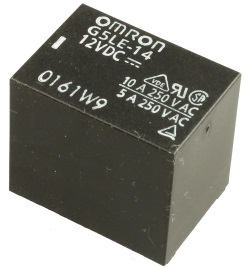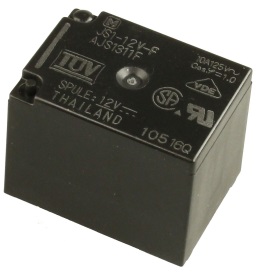XR Expansion SPDT 8-Relay Controller with General Purpose Relays
Highlights
- Eight On-Board General Purpose Relays
- Available with 5 or 10-Amp SPDT Relays
- On-Board Screw Terminal Connectors
- For General Purpose Switching Applications
- XR Input and Output Connectors
- Includes 6″ XR Expansion Cable
- On-Board Power and Relay Status LEDs
- Dual 2.1mm and Screw Terminal Power Connectors
- Compatible with ProXR AD8 and ProXR UXP Controllers
ProXR Relay Expansion Board with 8-Channel General-Purpose Relays
This Relay Expansion Controller includes 8 on-board general-purpose relays, capable of switching 5 or 10-Amps of current, depending on the variant chosen. This relay expansion controller is designed to plug into our ProXR series industrial relay controllers, and includes the required XR Relay Expansion Controller cable. On-Board status LEDs indicate the on/off status of each relay. This expansion controller operates on 12 Volts DC, and may be powered by connecting two-wires to the on-board screw terminal connector, or by plugging in power supply (sold separately) with a 2.1mm center positive barrel connector.
ProXR Expandability
ProXR Controllers were built with relay expansion in mind. Easily add different types of relays for high-power, signal, general purpose, or solid-state switching. The XR Expansion Port allows you to also add expansion boards and control up to 256 relays.

Above: A 4-channel ProXR Series Controller (bottom) shown with an 8-channel expansion board attached.
Simply chain the XR Expansion Modules, one after another, to add additional relays to any ProXR board up to 256 relays.
XR Expansion Port
XR Relay Expansion Controllers add a large variety of relay switching capabilities to an existing NCD ProXR series controller.
The XR Expansion Port is used to add banks of external relays to a ProXR Controller equipped with a XR Expansion port. As we continue to develop new devices, a modular architecture will be implemented, offering the greatest amount of user flexibility.
Controlling XR Expansion Banks
FXR Expansion Boards have no on-board brains. They are entirely reliant on the brains of a “master” ProXR device. The XR Expansion Modules have many possibilities:
- Adds up to 256 Relays to a ProXR Series Controllers
- Mix and Match Relay Types to Suite your Application Needs
- Choose Between Mechanical and Solid-State Relay Types
- Choose DPDT Relays for Signal Switching Applications
Linking XR Expansion Boards Together
XR Expansion Controllers consist of a XR Input and XR Output Connector. Simply connect the XR Output of your ProXR Controller to the XR Input located on the relay expansion board. Chaining more relays is easy. Simply connect the XR Output of your ProXR expansion board to the XR Input of your next relay expansion. Mix and Match different relay types as your application requires.
We always include a 6″ expansion cable with your expansion board. We can provide longer cables if needed, but it’s important to keep the cabling as short as possible. Not all users will be able to expand to 256 total relays, as it all depends on the installation, the amount of electrical interference, and the overall cable length. For best compatibility, the total length of the ProXR controller and all of the expansions and cabling should not exceed 1 or 2 meters.
Associated Part Numbers
This product may have been previously manufactured using a part number shown below:
Relay Options

10-Amp SPDT Signal Relay Option
This controller is available with a 10-Amp relay option, allowing control of higher-power loads up to an absolute maximum of 240VAC at 10 Amps. Ideal for general purpose switching applications, this relays is focused on power-switching, and should never be used for low-power signals due to a higher On resistance of up to 150 Ohms when relay contacts are new (contact resistance drops to less than 1 Ohm after break-in period). The 10-Amp relay is of the SPDT variety, which provides Common (C), Normally Open (NO), and Normally Closed (NC) connections. Common is connected to NC when the relay is off. Common disconnects from NC and connects to NO when the relay is activated. All connections are made via screw terminals, capable of accepting up to 12 AWG wire. Review Datasheet

5-Amp SPDT Signal Relay Option
This controller is available with a 5-Amp relay option, allowing control of higher-power loads up to an absolute maximum of 240VAC at 5 Amps. Ideal for general purpose switching applications, this relays is focused on power-switching, and should never be used for low-power signals due to a higher On resistance of up to 150 Ohms when relay contacts are new (contact resistance drops to less than 1 Ohm after break-in period). The 5-Amp relay is of the SPDT variety, which provides Common (C), Normally Open (NO), and Normally Closed (NC) connections. Common is connected to NC when the relay is off. Common disconnects from NC and connects to NO when the relay is activated. All connections are made via screw terminals, capable of accepting up to 12 AWG wire. Review Datasheet
Mechanical Drawing
Wiring Diagrams
Introduction to Relay Control
This video will guide you in determining which relay controller you need for your application as well as a general overview of the differences between Relay Options. If you’re new to our products or just need a refresher for a new application this is a great place to start.
Induction Suppression
Learn about Induction and how it comes into play with Relay Controllers. Induction suppression can make your Relay Control applications intermittent and unreliable. This video will show you what causes it, how to avoid it, and how to account for it in your application.
SPDT Relay Controller Specifications
This table covers all NCD SPDT Relay Controllers. All ratings assume 12VDC operation at 70°F (21°C). Please note that most ratings are estimated and may be subject to periodic revision. Some ratings represent stock controller settings without performance enhancement optimizations. The estimated processing time can be impacted by background services and choice of commands. Standby power consumption assume no communications module is installed and no relays are active on the controller. Please add the power consumption of the activated relays and communications module to obtain a better estimation of power consumption.| Specifications of NCD SPDT Relay Controllers | Minimum | Nominal | Maximum | Notes |
|---|---|---|---|---|
| Operational Voltages | 10VDC | 12VDC | 15VDC | |
| Standby Power Consumption | 35mA | 100mA | 200mA | No Active Relays, No Com Module |
| Relay Power Consumption | 28mA | 35mA | 60mA | Consumption of Each Activated Relay |
| Operational Temperature Range | -40°F (-40°C) | 70°F (21°C) | 185°F (85°C) | Theoretical Component Limits Shown |
| Storage Temperature Range | -67°F (-55°C) | 70°F (21°C) | 185°F (85°C) | Theoretical Component Limits Shown |
| Operational Ambient Air Humidity | 0% | 50% | 70% | Non-Condensing Humidity Values Shown |
| Relay Activation Time | 4ms | 5ms | 10ms | Needs Further Validation |
| Relay Deactivation Time | 5mS | 10mS | 15mS | Needs Further Validation |
ProXR vs. ProXR Lite
ProXR controllers include a XR Expansion port. This controller will plug into the XR expansion port of your ProXR series controller. ProXR Lite controllers do not include a XR Expansion port; therefore, this expansion will not work with ProXR Lite series controllers.
XR vs. FXR Expansions
XR and FXR expansions are very similar, but are not directly compatible with each other. The FXR expansion port is an updated version of XR, which includes a right-angle connector to support our metal enclosures. The FXR cable is also capable of carrying I2C data. Because of the right-angle connector, the polarity of the cable is not compatible with XR expansions.
Maximum Relay Rating Notes
ProXR is capable of expanding to an absolute maximum of 256 Relays. In some cases, it may not be possible to control all 256 relays, particularly in applications where high noise levels may be involved. Experimentation may be required, as it is not possible for us to guarantee all users will be able to utilize all 256 relays in every application. Noise tends to accumulate when several expansions are connected together. For best results, the XR expansion cables must be as short as possible. The typical total length of ProXR and all of its expansions and cabling should not exceed 1 or 2 meters.

